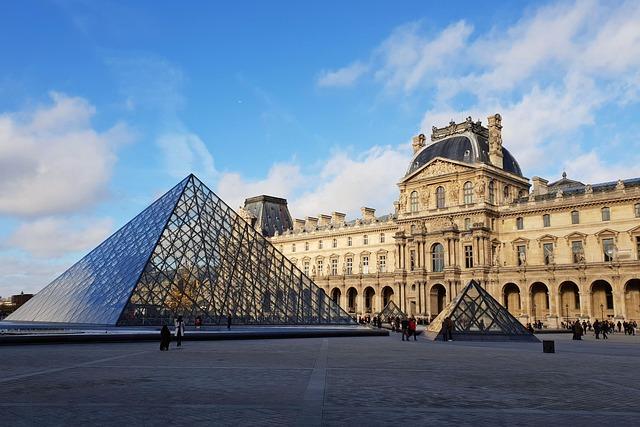The French government has confirmed that the precious jewels stolen from the Louvre in a daring heist were not privately insured, raising questions about the protection and valuation of cultural assets. The announcement comes as authorities continue to investigate the audacious theft that targeted some of the museum’s most valuable treasures. This revelation sheds light on the complexities of safeguarding national heritage and the challenges faced by public institutions in mitigating risks associated with high-profile art crimes.
Stolen Louvre Jewels Lack Private Insurance Raising Security Concerns
The recent jewelry heist at the Louvre has exposed significant vulnerabilities in the museum’s asset protection protocols. Authorities revealed that the stolen pieces were not covered by private insurance policies, a detail that has ignited debate over the adequacy of security measures in place. While the French government holds public insurance for national treasures, the absence of private coverage for these valuable items raises concerns about the financial and cultural ramifications of such crimes.
Experts argue that this incident could prompt a reassessment of insurance practices surrounding high-value artifacts in public institutions. Security specialists emphasize the need for:
- Enhanced risk management strategies tailored to unique museum assets.
- Integrating private insurance alongside governmental coverage to mitigate potential losses.
- Stronger collaboration between insurers, law enforcement, and cultural bodies to protect priceless collections.
Until changes are implemented, the Louvre—and other cultural landmarks—may remain susceptible to both financial risk and public trust erosion.
French Government Details Legal and Financial Implications of the Theft
The French government has emphasized that the priceless jewels stolen from the Louvre were not covered by private insurance policies. This revelation highlights the complexity of insuring cultural heritage items of such historic and artistic value. Instead, the responsibility for compensation and recovery falls squarely on the state, which manages both the assets and the legal frameworks surrounding national treasures. Officials are preparing to navigate these challenges while coordinating with international law enforcement agencies to facilitate the jewels’ return and pursue the perpetrators.
Legal and financial consequences include:
- State-funded investigation and recovery operations
- Potential legislative reviews to enhance security and insurance provisions for cultural assets
- Financial implications for restitution should the jewels be damaged or lost permanently
| Aspect | Details |
|---|---|
| Insurance Status | Not privately insured |
| Government Liability | Full responsibility |
| Estimated Recovery Cost | Confidential |
| Legal Action | Ongoing investigation |
Experts Recommend Increased Transparency and Public Insurance for Cultural Assets
The recent revelation that the stolen jewels from the Louvre were not covered by private insurance has sparked urgent calls among experts for a comprehensive reevaluation of insurance practices related to cultural heritage. Authorities and cultural organizations are now advocating for increased transparency regarding the insurance status of priceless artifacts, emphasizing the need to protect national treasures with robust, public-backed insurance schemes. This move aims to ensure that recovery efforts are fully supported and that future losses don’t result in uncompensated damage to a nation’s cultural wealth.
Key recommendations from industry specialists include:
- Implementation of publicly accessible registers detailing the insurance status of valuable cultural objects.
- Development of government-sponsored insurance funds tailored to art and heritage assets.
- Enhanced cooperation between museums, insurers, and law enforcement to expedite recovery and compensation.
| Insurance Category | Coverage Scope | Proposed Funding Source |
|---|---|---|
| Private | Individual artifacts, limited scope | Collectors and owners |
| Public | National collections and museums | Government and cultural grants |
| Hybrid | Shared risk models for valuable exhibitions | Public-private partnerships |
Calls Grow for Enhanced Museum Security Protocols and Preventative Measures
In the aftermath of the daring heist at the Louvre, experts and officials alike are urging museums across the globe to reexamine and strengthen their security frameworks. The revelation that the stolen jewels were not covered by private insurance has compounded the financial and cultural repercussions, highlighting significant vulnerabilities in asset protection strategies. Institutions are being called to implement comprehensive security audits and adopt advanced technologies such as AI-driven surveillance and biometric access controls to safeguard priceless collections.
Key preventative measures proposed include:
- Enhanced perimeter defenses to prevent unauthorized entry
- Real-time monitoring systems paired with rapid response teams
- Regular training for staff on emergency protocols and theft prevention
- Collaboration with law enforcement for intelligence-sharing and incident preparedness
| Security Aspect | Current Status | Recommended Upgrade |
|---|---|---|
| Surveillance | Basic CCTV | Integrated AI analytics |
| Artifact Tracking | Manual logs | RFID and GPS monitoring |
| Insurance Coverage | Limited | Comprehensive private and public policies |
| Emergency Response | Ad hoc team | Dedicated security task force |
The Conclusion
The revelation that the stolen Louvre jewels were not covered by private insurance raises critical questions about the museum’s risk management and the safeguarding of national treasures. As authorities continue their investigation into the audacious heist, the focus now turns to the measures that will be implemented to prevent similar incidents in the future. The French government faces growing pressure to enhance security protocols and ensure that priceless cultural artifacts are adequately protected for generations to come.




